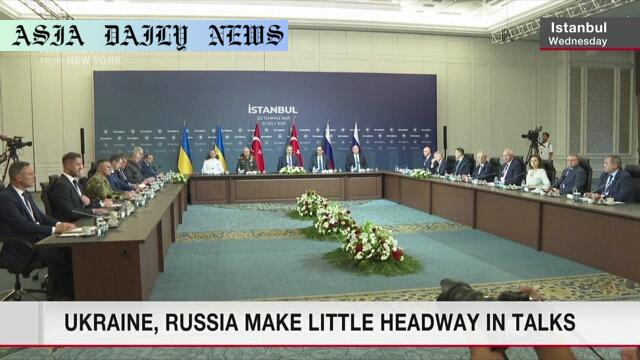Peace Talks: Ukraine pushes for leadership summit while Russia insists on concrete deal conditions before such a meeting.

The Context of Ukraine-Russia Peace Talks
Ukraine and Russia’s third round of peace talks in Istanbul highlighted the ongoing challenges in resolving this prolonged conflict. Led by Rustem Umerov, Ukraine proposed a summit between President Volodymyr Zelenskyy and President Vladimir Putin. This proposal emphasized the necessity of leadership-level discussions to address significant issues. They also suggested involving U.S. President Joe Biden and Turkish President Recep Tayyip Erdoğan as mediators.
However, Russia dismissed the idea of such a summit, citing the lack of pre-negotiated terms that could ensure productive discussions. Vladimir Putin’s aide, Vladimir Medinsky, who led the Russian side, argued that any meeting between the leaders should be used to finalize a deal, not to deliberate over conditions.
Key Outcomes of the Negotiations
While the two sides failed to reach common ground on a potential summit, there have been isolated agreements. Notably, the negotiators agreed to conduct a prisoner exchange involving at least 1,200 individuals. Though significant, this exchange only scratches the surface of the broader diplomatic complexities.
Ukraine maintained its stance on implementing a full and unconditional ceasefire as a prerequisite for moving forward diplomatically. Umerov stressed that such an action would demonstrate Russia’s constructive approach to the global community. Conversely, Medinsky’s focus on deal conditions before any ceasefire underscores the deep divide in priorities between the two nations.
Crucial Challenges to Address for Peace
One of the major sticking points is the sequencing of steps required to achieve peace. Ukraine’s push for a leadership summit and immediate ceasefire reflects its urgency in ending the conflict, which has taken a devastating toll on its citizens. Russia’s insistence on detailed pre-negotiations before discussing a ceasefire indicates a reluctance to commit without conditions favoring its strategic goals.
The involvement of external mediators, such as the U.S. and Turkey, remains another contentious issue. While international players could potentially facilitate discussions, they may also bring their strategic interests into the negotiations. Such dynamics could further complicate the already arduous efforts toward peace.
The Bigger Picture and Future Outlook
With active warfare continuing alongside diplomacy, time remains a critical factor. Incremental steps like prisoner exchanges offer glimmers of hope but do not address the root causes of the conflict. Both Ukraine and Russia face internal and external pressures to arrive at a resolution, making a clear framework and timeline for peace even more essential.
However, as highlighted in Wednesday’s talks, the parties are far from agreeing on this framework. Without substantive progress in forthcoming negotiation rounds, the human and economic costs of the conflict will likely escalate further. Perspectives from U.S., Turkish, and other global leaders may help bridge differences, but only if both Ukraine and Russia demonstrate a genuine willingness to compromise.
Commentary
The Fragile Hope of Negotiations
When diplomacy is the sole bridge between war and peace, every meeting carries immense stakes. The recent peace talks between Ukraine and Russia vividly illustrate this reality. While the idea of a high-level leadership summit proposed by Ukraine could have been a game-changer, Russia’s dismissal of the proposal underscores how deeply entrenched both sides remain.
It is hard not to empathize with Ukraine’s urgent calls for a ceasefire, given the devastating toll the conflict has taken on its people and infrastructure. The emphasis on a summit speaks to the belief that only high-level discussions can address the broader frameworks of peace and security. On the other hand, Russia’s insistence on preconditions may reflect skepticism about Kyiv’s intentions, or conversely, Moscow’s preference for securing its advantages first.
Challenges Posed by External Actors
The role of external players like the U.S. and Turkey offers a potential break in the stalemate but also carries risks. On the one hand, these countries could act as impartial mediators, fostering an environment of trust. On the other hand, their political interests might come into play, complicating negotiations further. Whichever way these dynamics evolve, their involvement highlights the global dimensions of this local conflict.
One positive aspect of the Istanbul meetings was the mutual agreement on a prisoner exchange. While this is a humanitarian milestone, it is merely a drop in an ocean of unresolved issues. For the sake of global stability, these talks must evolve beyond symbolic moves to substantive agreements.
Final Thoughts
Ultimately, these talks remind us that peace is hard-earned, requiring patience, diplomacy, and concessions. Despite the failures and frustrations of this most recent round, the dialogue itself is a small but essential step forward. Both Ukraine and Russia must seize upcoming opportunities to push for real compromises, for only then can we hope to see an end to this tragic chapter of modern history.


